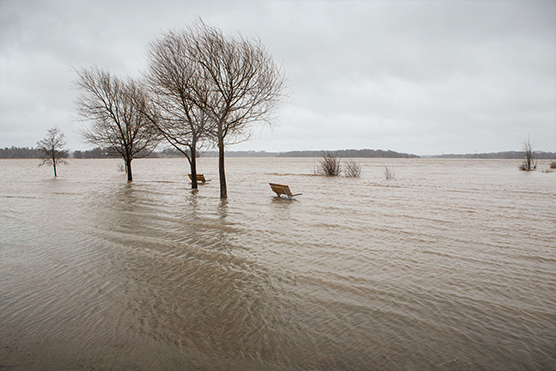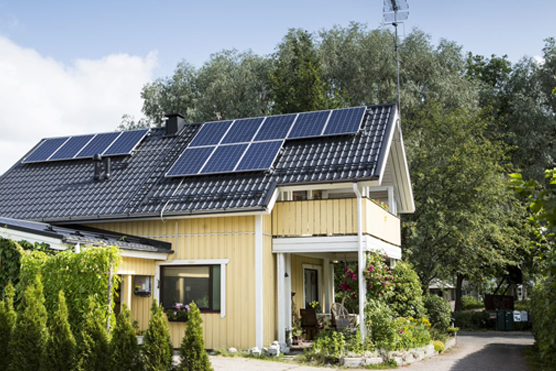Leadership in ongoing collaborative projects
Mapping the future to anticipate climate change impacts and risks

© Kai Widell.
SYKE research has presented scenarios for Finland that describe different ways in which our climate and society could develop in the future. Scenarios can help us to appreciate how these alternative developments may lead to a range of impacts on aspects of our environment, such as terrestrial and marine systems, biodiversity and water management. This understanding can help us to devise suitable policies for adapting across diverse outcomes. Notably, the PLUMES consortium, funded by the Academy of Finland, produced or co-produced nearly 40 scientific papers and 20 press releases, news items or blogs. The project also contributed to eight completed or ongoing doctoral theses as well as numerous reports. The European Meteorological Society awarded its Young Scientist Award 2017 for one of the scientific papers, lead-authored by Juha Aalto from the Finnish Meteorological Institute.
National assessments are key to changes in policy
SYKE research led to the development of the world’s first national climate change adaptation strategy, in 2005, based on the FINADAPT project that SYKE coordinated. SYKE researchers were also heavily involved in development of the national climate change adaptation plan of 2014, including its interim evaluation in 2017-2018. SYKE has also highlighted under-researched areas, such as the cross-border impacts of climate change, conducting one of the first national assessments in Europe. This work continues in the EU-funded project CASCADES.
SYKE consults the Ministry of the Environment and the Ministry of Agriculture and Forestry on adapting to climate change in the built environment, water management, and the protection of biodiversity. SYKE’s results and guidance have been used by the Helsinki Metropolitan region and City of Helsinki in implementing the EU Flood and Water Framework Directives.
Stressing the need for policy harmonization
The CHAMPS project, funded by the Academy of Finland, concentrates on the health impacts of climate change and a new project, Adapt-FIRST will examine impacts across various sectors to assess the urgency for adaptation. This intersects nicely with SYKE’s continued policy research to support the revision of the Climate Change Adaptation Plan 2022, following closely from earlier input to revisions of the Finnish Climate Act.
On an international level, SYKE has advised the European Environment Agency (EEA) on climate change impacts and the need for vertical policy integration, as was also examined in the BASE project (https://base-adaptation.eu/about-base) coordinated by Aarhus University. SYKE has also been active in agricultural model inter-comparison and improvement studies, as part of large research networks in the European FACCE-JPI Knowledge Hub, MACSUR, and the global AgMIP program.
For more on the impacts:
- Benzie, M., Carter, T. R., Carlsen, H., & Taylor, R. (2019). Cross-border climate change impacts: implications for the European Union. Regional Environmental Change, 19(3), 763-776.
-
National Action Plan for the Adaptation to Climate Change 2016 (PDF)
-
Pathways linking uncertainties in model projections of climate and its effects (PLUMES)
- Saranko et al. 2020: Impacts of town characteristics on the changing urban climate in Vantaa
- Mikael Hildén, Glada Lahn, Timothy R. Carter, Richard J. T. Klein, Ilona M. Otto, Benjamin Pohl, Christopher P. O. Reyer and Fabien Tondel, CASCADES brief, January 2020: Cascading climate impacts: a new factor in European policy-making (PDF).
-
International project on high end scenarios, IMPRESSIONS, Impacts and risks from high-end scenarios: strategies for innovative solutions
-
The EU research project "Bottom-Up Climate Adaptation Strategies Towards a Sustainable Europe" (BASE)
-
Climate guide in Finland
Cutting black carbon emissions slows warming in the Arctic
In 2017, SYKE published a Policy Brief on how soot, also known as black carbon, heats up especially the Arctic region, and how to curb these emissions. The text was published in Finnish, English and Russian, and it has been referred to exceptionally extensively as background material both in Finland and in international summits. SYKE research continues to model the locations of emission sources and draw forecasts for the next 50 years.
Sauli Niinistö, the President of Finland, drew attention to black carbon especially in the Arctic Council during the Finnish presidency. SYKE chaired the Arctic Council black carbon and methane working group. Niinistö also took up the issue in his meeting with President Donald Trump and with President Vladimir Putin. The SYKE Policy Brief gained a wide domestic and international readership. It is one of the most downloaded SYKE policy briefs.
Local black carbon takes heavy toll
According to the brief, curbing greenhouse gas emissions is of highest importance in combating global warming, but also black carbon emissions must and can be reduced, which takes immediate effect on the climate. This is done by adopting the best technical solutions and by tightening emission restrictions. The Arctic is warming up twice as fast as the rest of the world. By adopting the best technologies, the warming effect of black carbon in the Arctic can be reduced by approximately 0.25 degrees centigrade by 2050. A third of the warming of the Arctic caused by black carbon is caused by black carbon originating in the Arctic.
The most important measure is to reduce flaring of surplus gas within the oil industry. The big energy and manufacturing facilities in the Arctic region have largely already adopted black carbon reducing technologies. However, some old, inefficient facilities remain whose emissions are extensive. Emission reductions also improve the health of locals, especially in urban areas.
Engaging towns and companies
SYKE research on black carbon has produced tens of scientific articles in high-impact journals (including co-authoring in Science) and reports. The work and results have been presented to the scientific community in numerous conferences and workshops.
The on-going project and other activities will contribute to e.g. bringing BC mitigation activities into municipal climate measures and improved collaboration with cities and companies.
At international fora, new active contacts, in addition to earlier IIASA and several Nordic partners, include emission inventory development with TNO, and the Japanese NIES institute with a broad spectrum of BC related issues (the latter fulfilling also the SYKE-NIES collaboration contract signed in 2017).
For more on the impacts:
-
Finnish Regional Emission Scenario model FRES, project website with publications and presentations etc
- Klimont, Z., Kupiainen, K., Heyes, C., Purohit, P., Cofala, J., Rafaj, P., ... & Schöpp, W. (2017). Global anthropogenic emissions of particulate matter including black carbon. Atmospheric Chemistry and Physics Discussions, 17(14), 8681-8723.
-
Curbing black carbon emissions slows warming in the Arctic - SYKE Policy Brief
Climate impact of forest biomass use
SYKE has actively promoted scientific and public discussion and research on the use of forest biomass and its impact on climate change. Through various projects and other activities SYKE has analysed the role of forest biomass use as a driver or mitigator of climate change, and the ways of incorporating this knowledge to climate strategies and policies. In addition, SYKE has contributed to the development of related regulation.
The issue of forest biomass is particularly important in Finland where forest-based industries play a major role in the country's economy with an annual cut of nearly 70 million cubic metres of roundwood. The crucial question is how wood harvesting affects the carbon stocks of forest as well as carbon sinks and emissions in a situation where most of the wood harvested ends up in short-lived products or combustion, and what are the time scales.
SYKE's projects have brought answers to this question, identified uncertainties related to it, and created climate-relevant targets for the use of forest biomass. The development of forest carbon accounting has also been enhanced.
SYKE's efforts in this sector have received significant publicity and thereby raised general awareness on the issue. Results of projects have been presented in several events, including the European and the Finnish parliaments, and information has been actively circulated through both traditional and new media.
Furthermore, SYKE's experts on this topic have played an important role in the production of several documents which have gained much visibility. These include two synthesis reports of The Finnish Climate Change Panel, an open letter on climate, biodiversity & forestry targets signed by 68 scientists, and the impact assessment of the National Energy and Climate Strategy of 2016. Due to these and other SYKE's outputs the general discussion on the topic – although still somewhat polarized – has started to converge with scientific results.
For more on the impacts:
Guiding municipalities toward carbon neutrality

© Kai Widell.
The Finnish Environment Institute SYKE coordinates and supports several municipalities and regions in their climate mitigation efforts. In 2008, SYKE and seven Finnish corporate executives established the Towards Carbon Neutral Municipalities, Hinku, network in order to show how climate change mitigation could benefit every aspect, be it economic, environmental or social. The municipalities in the network have committed to an 80 percent reduction in greenhouse gas emissions from 2007 levels by 2030.
The emissions reduction roadmaps of municipalities are based on SYKE carbon emission calculations. Hinku member municipalities and the people, companies and farms within carry out more climate change mitigation measures than they otherwise would. The network started with 5 small municipalities, now it comprises 73 municipalities with 1.9 million inhabitants.
Winning recognition from the EC
The EU Eionet network selected Hinku as one of 8 examples of how societies can catalyze and steer sustainability transitions. In 2017, the municipality of Ii, a member of the Hinku network, came first in the Energy Union: Climate Change category of the European Commission's RegioStars Awards.
Based on the experiences gained from the Hinku network, SYKE coordinated and planned, together with a variety of relevant stakeholders, a 15-million-euro project to make happen the National Energy and Climate Strategy and the Medium-Term Climate Change Policy Plan.
Towards Carbon Neutral Municipalities and Regions (Canemure) is a SYKE-led six-year project (2018-2024) funded by the EU Life program. The Canemure consortium consists of 22 partners and 15 co-sponsors supporting the Hinku network, climate work at the regional level, and concrete measures through demonstrations and pilots.
Knowledge accessible to anybody
SYKE has produced a database for GHG emissions of Finnish municipalities and regions and information to support e.g. investments of renewable energy in the municipalities. All the information is readily accessible to anyone. Also, several working papers and professional articles have been published.
For more on the impacts: